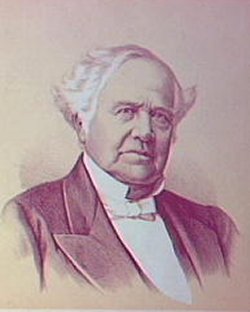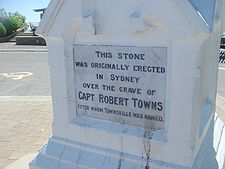
Robert Towns
Encyclopedia

Queensland
Queensland is a state of Australia, occupying the north-eastern section of the mainland continent. It is bordered by the Northern Territory, South Australia and New South Wales to the west, south-west and south respectively. To the east, Queensland is bordered by the Coral Sea and Pacific Ocean...
.
Towns was born at Longhorsley
Longhorsley
Longhorsley is a village in Northumberland, England about northwest of Morpeth, and about south of Alnwick. The A697 road passes through the village linking it with Morpeth, Wooler and Coldstream in Scotland. There are 6 "Streets" in Longhorsley: Whitegates, Church View, Drummonds Close, West...
, Northumberland
Northumberland
Northumberland is the northernmost ceremonial county and a unitary district in North East England. For Eurostat purposes Northumberland is a NUTS 3 region and is one of three boroughs or unitary districts that comprise the "Northumberland and Tyne and Wear" NUTS 2 region...
, England, on 10 November 1794. This is the date usually given, and it agrees with his death notice in the Sydney Morning Herald of 12 April 1873 which stated that he was then in his seventy-ninth year. The date given by the Australian Encyclopaedia, 1791, appears however, to be more likely, as after being educated at a village school Towns went to sea, was a mate in 1811, and a master in the following year. In 1813 he was captain of a brig
Brig
A brig is a sailing vessel with two square-rigged masts. During the Age of Sail, brigs were seen as fast and manoeuvrable and were used as both naval warships and merchant vessels. They were especially popular in the 18th and early 19th centuries...
in the Mediterranean, and in 1827 he made his first voyage to Australia as captain of The Brothers.
In 1833 he married the sister of W. C. Wentworth, and in 1842 established a mercantile and shipping business (Robert Towns & Co., General Merchants, Ship and Commission Agents) at Sydney. In a letter to William de Salis
William Andreas Salicus Fane De Salis
William Andreas Salius Fane de Salis was a businessman, colonialist, and barrister.De Salis was the third son of Jerome, 4th Count de Salis-Soglio , by his third wife, Henrietta Foster . Peter John Fane, Count de Salis was an elder half-brother. William Foster Stawell was a first cousin, and the...
dated Sydney, 4 January 1853 Towns describes a shipping issue:
- 'I am afraid our CoolieCoolieHistorically, a coolie was a manual labourer or slave from Asia, particularly China, India, and the Phillipines during the 19th century and early 20th century...
trade is over, the rascals have been so troublesome, nobody likes to employ them, and our laws are so defective & punishment so trifling for such offences that they laugh at the idea of being put in Gaol - It is possible she may get a Charter elsewhere with Coolies...'
He afterwards bought station properties in Queensland, and about 1860 or a little later began growing cotton
Cotton
Cotton is a soft, fluffy staple fiber that grows in a boll, or protective capsule, around the seeds of cotton plants of the genus Gossypium. The fiber is almost pure cellulose. The botanical purpose of cotton fiber is to aid in seed dispersal....
, employing South Sea islanders to do the cultivation and picking. Many attempts had been made to grow cotton in Australia before this time, but Towns was the first to do so on a large scale. Realizing that a port was needed on the Queensland coast north of Bowen
Bowen, Queensland
Bowen is a town on the eastern coast of Queensland, Australia. At the 2006 census, Bowen had a population of 7,484.-Geography:Bowen is located on the north-east coast of Australia, at exactly twenty degrees south of the equator. In fact, the twentieth parallel crosses the main street...
, Towns arranged for explorations to be made from his stations, a suitable site was found at Cleveland Bay
Cleveland Bay
The Cleveland Bay is a breed of horse that originated in England during the 17th century, named after its colouring and the Cleveland district of Yorkshire. It is a well-muscled horse, with legs that are strong but short in relation to the body. The horses are always bay in colour, although a...
, and on to October 1865 it was gazetted as a port of entry and named Townsville.
Towns had been a member of the legislative council from 1856, and, although he did not take a leading part in politics, his advice was much sought in matters affecting business.
Working until near his death, Robert Towns died in Sydney on 11 April 1873. The memorial stone from his Sydney grave now stands atop a monument at Castle Hill, Townsville
Castle Hill, Townsville
Castle Hill is an isolated pink granite monolith standing in the heart of the north Queensland city of Townsville. It rises to a height of some 286 metres above sea level and dominates the city skyline. It is one of the most distinctive natural features on the Queensland coast...
. He lived from 1864 to 1873 in Cranbrook House
Cranbrook
-People:* Earl of Cranbrook, title in the Peerage of the United Kingdom** Gathorne Gathorne-Hardy, 1st Earl of Cranbrook , British Conservative politician** John Stewart Gathorne-Hardy, 2nd Earl of Cranbrook , Conservative Member of Parliament...
.



